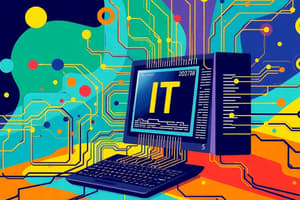Podcast
Questions and Answers
Which of the following best describes the primary role of networking in IT?
Which of the following best describes the primary role of networking in IT?
- Providing physical hardware for computing tasks.
- Connecting devices to share resources and communicate. (correct)
- Creating software applications to enhance functionality.
- Maintaining structured databases for data storage.
What is the primary focus of cybersecurity within the scope of IT?
What is the primary focus of cybersecurity within the scope of IT?
- Protecting systems and data from unauthorized access. (correct)
- Enhancing application performance.
- Developing user-friendly software interfaces.
- Managing network traffic efficiently.
Which area of IT primarily involves the analysis and processing of large datasets?
Which area of IT primarily involves the analysis and processing of large datasets?
- Big Data (correct)
- Network Administration
- Cybersecurity
- Software Development
What constitutes IT governance?
What constitutes IT governance?
What is the role of a data analyst in IT?
What is the role of a data analyst in IT?
Which IT trend focuses on the automation and intelligent decision-making tools?
Which IT trend focuses on the automation and intelligent decision-making tools?
What is a significant challenge faced by the IT industry related to evolving tools?
What is a significant challenge faced by the IT industry related to evolving tools?
Which function is primarily responsible for the maintenance and organization of structured data collections?
Which function is primarily responsible for the maintenance and organization of structured data collections?
Study Notes
Overview of IT (Information Technology)
- Definition: Use of computers, software, networks, and databases to manage information.
- Functions: Data storage, processing, retrieval, and communication.
Components of IT
- Hardware: Physical devices (computers, servers, networking equipment).
- Software: Applications and operating systems that perform tasks on hardware.
- Networking: Connecting devices to share resources (internet, intranets).
- Databases: Structured collections of data for easy access and management.
Areas of IT
- Software Development: Creation of applications and systems.
- Network Administration: Management of networks to ensure optimal performance.
- Database Management: Organizing and maintaining databases.
- Cybersecurity: Protection of systems and data from unauthorized access and attacks.
- Cloud Computing: Delivery of services over the internet (storage, processing).
IT Management
- Project Management: Planning, executing, and controlling IT projects.
- IT Governance: Framework and processes to ensure IT investments align with business goals.
- Help Desk Support: Technical support for users experiencing issues with IT systems.
IT Trends
- Artificial Intelligence (AI): Automation and intelligent decision-making tools.
- Big Data: Analysis and processing of large data sets for insights.
- IoT (Internet of Things): Interconnected devices that communicate and share data.
- Blockchain: Secure, decentralized ledger technology for transactions.
Challenges in IT
- Security Threats: Malware, phishing, and other cyber threats.
- Data Privacy: Compliance with regulations like GDPR and CCPA.
- Technological Changes: Keeping up with rapid advancements and evolving tools.
Importance of IT
- Business Efficiency: Streamlining operations and improving productivity.
- Decision Making: Utilizing data analytics for informed choices.
- Innovation: Enabling new products and services through technology.
Career Paths in IT
- Software Developer: Designs and writes software applications.
- Network Engineer: Focuses on networks' design and implementation.
- Data Analyst: Analyzes data to track trends and make recommendations.
- Cybersecurity Specialist: Protects systems and networks from cyber threats.
Conclusion
- IT is a crucial field that drives efficiency, innovation, and security in various industries. Staying updated on trends and advancements is essential for professionals in the sector.
Overview of IT
- IT uses computers, software, databases, and networks to manage information.
- IT facilitates data storage, processing, retrieval, and communication.
Components of IT
- Hardware includes physical devices like computers, servers, and networking equipment.
- Software consists of applications and operating systems that drive tasks on hardware.
- Networking interconnects devices to share resources like the internet and intranets.
- Databases are structured collections of data organized for easy access and management.
Areas of IT
- Software Development involves creating applications and systems.
- Network Administration ensures networks function optimally by monitoring, maintaining, and troubleshooting.
- Database Management involves organizing, maintaining, and securing databases.
- Cybersecurity protects systems and data from unauthorized access and attacks.
- Cloud Computing delivers services like storage and processing over the internet.
IT Management
- Project Management involves planning, executing, and controlling IT projects.
- IT Governance establishes a framework and processes to align IT investments with business goals.
- Help Desk Support provides technical support to users experiencing issues with IT systems.
IT Trends
- Artificial Intelligence (AI) uses automation and intelligent decision-making tools.
- Big Data analyzes and processes large data sets to extract insights.
- IoT (Internet of Things) involves interconnected devices communicating and sharing data.
- Blockchain is a secure, decentralized ledger technology used for transactions.
Challenges in IT
- Security threats include malware, phishing, and other cyber threats.
- Data Privacy compliance with regulations like GDPR and CCPA is crucial.
- Technological Changes necessitate keeping up with rapid advancements and evolving tools.
Importance of IT
- Business Efficiency: Streamlining operations and improving productivity.
- Decision Making: Utilizing data analytics for informed choices.
- Innovation: Enabling new products and services through technology.
Career Paths in IT
- Software Developer: Designs and writes software applications.
- Network Engineer: Focuses on networks' design and implementation.
- Data Analyst: Analyzes data to track trends and make recommendations.
- Cybersecurity Specialist: Protects systems and networks from cyber threats.
Conclusion
- IT plays a vital role in driving efficiency, innovation, and security across industries.
- Staying current with emerging trends and advancements is essential for IT professionals.
Studying That Suits You
Use AI to generate personalized quizzes and flashcards to suit your learning preferences.
Description
This quiz explores the fundamental aspects of Information Technology (IT), including its definition, key components, and various areas of application. Test your knowledge on hardware, software, networking, databases, and the importance of IT management in today’s digital landscape.




